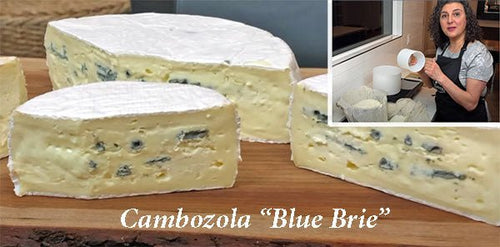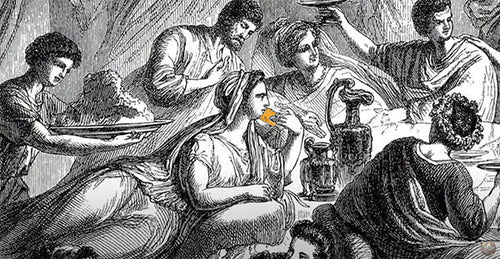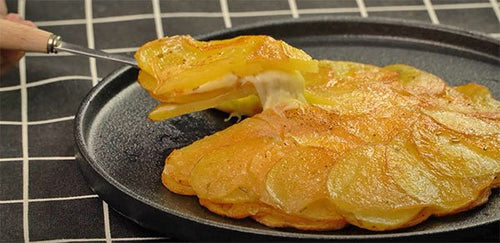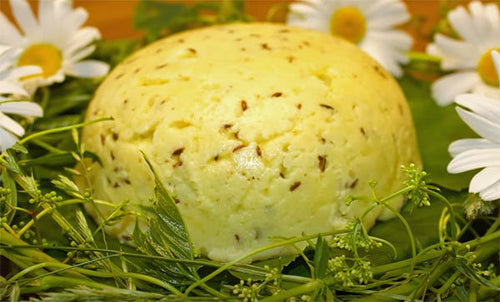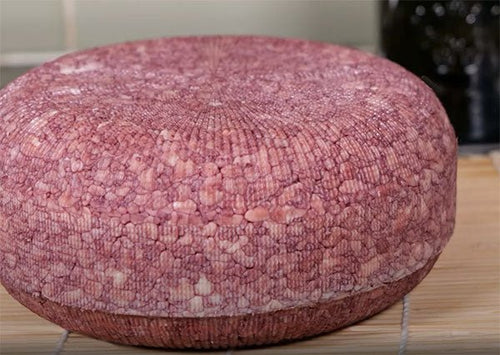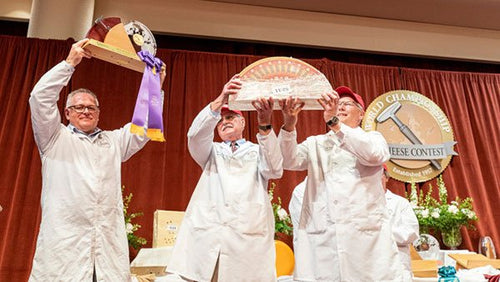Cheese Making Recipe of the Month
Pepato Toscano - A Tuscan style cheese
This is one of my favorite cheeses so I have made it with 2 types of peppers here ....cracked peppercorns & home smoked jalapenos.
Cheese Making Questions & Answers
White Mold Rinds?, Cheese is to acid?, Natural Rinds?
Q. I Have been experimenting with St. Maure Goat Cheese and the likes (Soft ripened goat cheese). Using P. Candidum and Geo 15. The white mold starts just fine but then it seems to form a skin and separate from the cheese. How would I get the skin to stick better to form a better rind? It doesn't seem to be infected. I keep the cheeses in their own plastic boxes. I have refrigeration at 55 F. and 40 and below to hold them plus room temperature @ 72 F.
A. The problem is not the skin... it is from too much residual moisture in the early curd caused by one or all of the following:
- In the early part of your process you are not setting your milk firm enough and hence it becomes more difficult to drain
- You are not draining them well enough before drying off (can be a problem w/ late lactation milk) ...remember that the curd will loose 10-20% moisture in the drain/dry phase
- You are not drying enough or fast enough before the mold starts to form. Using a fan may help and keep the RH below 75-80%
In a nutshell what is happening is that your mold begins to form before the cheese has dried down to it's desired size... once the mold forms it's jacket and the curd continues to shrink due to moisture loss the cheese becomes a size to small for it's coat... another problem here is that this is also the area where protein breakdown (Proteolysis) happens the fastest with excess moisture and can result in a very runny paste, which is why the skin will fall away... these cheese generally ripen very early near the surface while they are chalky and firm in the middle
Again... get the moisture drained and the surface dried off as quickly as possible.
The ideal target here is optimum moisture in the cheese coincides w/ the beginning of the mold growth .. about 5 days
Cheese is too Acidic! ...
Q. I recently opened up a horn of gouda that I had aging for 3 weeks. The cheese wasn't bad but it was very sharp. (it was also my first lb. of cheese I have ever made so I am not too worried)
I think the problem is with my aging. I don' t have anywhere that will keep at 50 degrees. I aged in my basement but I think the room is more like 65 degree. Is this likely my problem?
A. First off, your gouda problem was probably happening within the first 48 hrs of making it.. the sharpness is probably due to late acid development... essentially this happens when you do not remove enough lactose from the curd.. this lactose is used by the culture to increase the acid and will keep producing acid until the lactose is removed/used up, the salt content gets high enough to stop it, or the temp drops below the working conditions for the culture...
The primary method used to stop this acid production is to remove most of the lactose early in the process by stirring the curd longer or increasing the temp, causing it to shrink thus forcing the whey/lactose out .. proper salting or brining is also needed to stop the acid.
Gouda is a sweet cheese and the removing of the whey and adding warm water is another method to remove the lactose and therefore ending up w/ a cheese of pH 5.2-5.4.
Finally the temp at which you are aging is not helping you .. 65 is going to encourage the acid production.. you should get the temp well below 60F and preferrably 52-54F
Natural Rinds! ...
Q. I have become passionate about making cheese and have found your web site to be wonderful. I have had great success making two types of hard cheeses from your recipes. However, the drying period has confused me a bit. I know you recommend an old refridgerator. I have an unfinished basement that maintains a constant temperature of around 55 degrees. I placed my cheese in a rubbermaid storage bin in my basement and have turned it daily. How much mold should develop and how often should I wipe the mold off of the cheese? I really enjoy hard cheeses but have found this step frustrating. Any help you can give would be much appreciated!
A. You are quite lucky to have such a basement ... the plastic boxes may be holding a bit more moisture than would be ideal, hence the ongoing mold problems ... proper humidity should be in the 75-85% range for hard cheeses
The amount of mold on your cheese depends a lot on how you would like them to develop.
Cleaner rinds do make a more appealing presentation but involve more work.
It would be best to keep the mold at bay by frequent wiping or brushing because with more moisture you will need to attend to them more often.
The key to these natural rinds is to dry them off well post-salting, before placing them in the aging room
You may need to spend more time in the beginning with them, but after a month or so every other week should be enough.
Have a cheese making question, we're here for you: info@cheesemaking.com
Meet Some Fellow Cheese Maker
Terry and Linda Clapp
Farmstead Cheese ... Little House Cheese
These folks have packed a lot into one of the smallest little cheese houses we have seen.
Andrea Lewis
Andrea has come to our attention because of all the questions she has asked us ... a sign of progress we know.
She has sent us a pretty good description of what it has been like to start from scratch to make cheese at home ..
What's new at cheesemaking.com
Buffalo Dairy
Ricki has recently changed her 'rennet added' cultures to now include a powdered vegetable rennet in place of the cows rennet since so many people would prefer this.
For these fresh cheeses this will now work exactly as it did in the past ... plus you will make your vegetarians happy.
These include
The New Updated Edition of 'Italian Cheese' has arrived.
Here is another new book from the 'Slow Foods' People. This is the 2nd Edition w/ 50% more cheeses being included for a total of 293.
The descriptions give plenty of critical info on make temps and more. Enough background tips to help cheese makers get started on their own recipes.
Ricki has a Great Deal for the new beginning cheese maker ...
Her 3 most asked for items as a package
_The newly revised book Home Cheese Making (which she will sign)
_the 30 Minute Mozzarella & Ricotta Kit
_AND Cheesemaking 101 Video
all for only $50.00
Also Ricki has recently converted her ever popular Video'Cheesemaking 101' to DVD
This is probably one of the most often asked questions we get:
"After we make our cheese how do we manage to age it properly?"
You spend all of your time getting that perfect cheese made
... and then what? How do you get it through the ripening stage without it drying out or becoming covered with mold?
What are the conditions we need for aging cheese and how do we accomplish it without spending a fortune?
Well.. the good news is that people have been doing this for many years by simply using a cool corner in their cellar or today using an unused fridge.
We explain the details of it all here.
A Great Cheese Related Web Site
A recent participant in one of our workshops has set up a great information site
This site contains a number of interesting bits relating to all aspects of cheese making and appreciation.
It is also setup for user contributions
The Loss of a Cheesemaking Friend
"After we make our cheese how do we manage to age it properly?"
You spend all of your time getting that perfect cheese made
... and then what? How do you get it through the ripening stage without it drying out or becoming covered with mold?
What are the conditions we need for aging cheese and how do we accomplish it without spending a fortune?
Well.. the good news is that people have been doing this for many years by simply using a cool corner in their cellar or today using an unused fridge.
We explain the details of it all here.
Please send your cheese making news & photos to: moosletter@cheesemaking.com
























































































